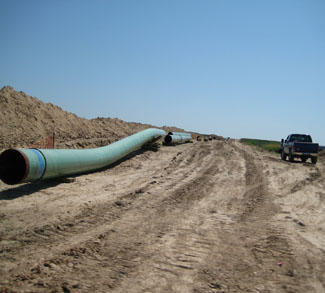Last month, a US State Department review indicated the Keystone XL pipeline was unlikely to have a significant impact on climate change; one of President Obama’s key concerns about the project. For a little while, it looked like the controversial pipeline might finally be nearing approval. However, as has often been the case with this project, things weren’t as they seemed. Buried deep in the details of report were some critical comments from the Environmental Protection Agency (EPA), and at time of writing the Keystone XL’s fate is as hazy as it has ever been.
Environmental concerns have been the most publicized aspects of the pipeline, with opponents arguing that the project could accelerate climate change by enabling increased production in Alberta’s oil sands, which create 17% higher greenhouse gas emissions than the average crude used in the United States. President Obama will ultimately make the final decision on the pipeline and, given his campaign against climate change, it is difficult to imagine him defying the EPA and his core Democrat base, especially with midterm elections looming later this year. Then again, some labor unions will be furious if he cancels the pipeline and the many thousands of jobs it could create. Given the powerful interests on both sides of the debate, it’s not surprising that he has taken so long to come to a decision.
Keystone XL: Then and Now
A lot has changed since TransCanada first proposed the project seven years ago. Back in 2007, there were still concerns that “peak oil” was imminent and demand for energy was booming in the pre-financial crisis environment. The pipeline was initially viewed by many as a much-needed tool to develop Canadian oil reserves and ease supply concerns. But now the United States is apparently nearing energy independence and the Keystone XL project is widely seen as an environmentally unsafe method of transferring oil to major refiners on the Gulf Coast.
Oil companies have not been sitting idle during this prolonged approval process. Instead they have been working on other methods of transporting Canadian oil. The refiner Valero signed on to receive oil from the Keystone XL pipeline early in the project’s life cycle and has spent billions upgrading its equipment to handle the type of heavier crude produced in Canada. So to make good on their early investment, the firm has invested in rail terminals at its refineries to help get the oil in. Last month, Exxon Mobil announced the construction of a rail facility in Alberta that will be completed early next year.
Oil-by-rail has attracted public scrutiny following a series of recent accidents, most notably a crash in Quebec last year that killed 47 people. Safety concerns might bring additional regulation such as railcar modifications, but such developments will only result in a short-term slowdown in rail expansion. Companies will continue to aggressively pursue this transportation method as long as the Keystone XL pipeline remains in limbo.
The Economic Impact of Keystone XL
The economic impact of the pipeline has generated much debate, but despite heated arguments from both sides, its potential effect remains unclear. TransCanada claims Keystone XL will support approximately 42,100 direct, indirect, and induced jobs in the United States, providing a substantial increase in tax revenues for local counties along the pipeline route, with 17 of 27 counties expected to see revenues increase by 10% or more. It added that the project will result in “spending $7 billion stimulating the local economy.”
These claims have been countered by the Cornell Global Labor Institute, which says the project budget that has a direct impact on US employment is between $3 and $4 billion. Moreover, any jobs created would be temporary and between 85-90% of the people hired to do the work would be non-local or from out-of-state. It also warned of the economic risks from possible pipeline spills, pollution, and the rising costs of climate change. But there is no way of quantifying these risks.
The Consumer Impact
Another argument revolves around the potential impact on oil prices. Intuition would say that the more oil coming into the US, the cheaper prices become. But the market isn’t so straightforward. Since 2011, refineries in the Midwest have benefitted from a glut of oil produced in the region and Canada, which was easily accessible thanks to an array of pipelines that were granted approval. This has seen US WTI crude oil trade up to $20 less than the global benchmark, Brent, over the last year. The spread was about $8 last week. However, if the Keystone XL pipeline enables the efficient transport of oil from Canada to the Gulf, then more refiners will be bidding for the oil. It is feared that increased competition for the Midwest oil glut will see an increase in prices.
Yet, like predicting anything in financial markets, there is no certainty about future prices. Nobody knows how much oil will cost next year, but the logical policy is to create the most efficient oil transportation network so that supplies can be maximized, thus lessening the impact of a price shock brought about by unexpected events.
Efficiency demands the full development of the Keystone pipeline. Even if Obama rejects the proposal, companies will pursue other methods of transporting oil from Canada, and as has been demonstrated, oil-by-rail is not a risk-free alternative. Rejecting Keystone XL won’t reduce the production of heavy oil in Alberta. That will only happen when better energy alternatives are promoted.
The opinions, beliefs, and viewpoints expressed by the authors are theirs alone and don’t reflect any official position of Geopoliticalmonitor.com.




